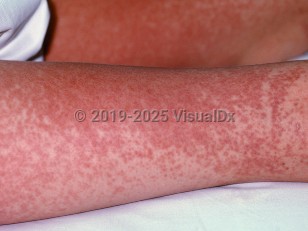Drug-induced hypersensitivity syndrome in Child
Alerts and Notices
Important News & Links
Synopsis

All potential culprit drugs should be stopped immediately. Optimize supportive care (such as fluid replacement or dressing changes) for any specific organ dysfunction. The use of systemic corticosteroids has been advocated in patients with signs and symptoms of internal organ involvement. The dose of steroids depends on the severity of the reaction, but a dose of 1-2 mg/kg prednisone daily (maximum daily dose: 60 mg/day) in children and adolescents is a good starting point.
Diagnosis Overview:
Drug-induced hypersensitivity syndrome (DIHS) is a potentially severe idiosyncratic drug reaction with systemic manifestations including fever, rash, and internal organ involvement, most typically hepatitis. The acronym DRESS, for drug reaction with eosinophilia and systemic symptoms, was proposed as a more specific term in 1996. However, because only 60%-70% of patients demonstrate eosinophilia, many have suggested using DIHS to avoid confusion.
DIHS is a type IV hypersensitivity reaction, but the specific immunopathogenetic mechanisms underlying this condition are not fully elucidated, and they may vary between patients and specific drugs. Defects in the detoxification of anticonvulsants and sulfonamides have been demonstrated in patients with DIHS as well as human leukocyte antigen (HLA) types, which have varying prevalence in different racial and ethnic groups. Human herpesviruses 6 and 7 (HHV-6 / HHV-7), Epstein-Barr virus (EBV), and cytomegalovirus (CMV) reactivation have also been demonstrated in many of these patients, although the pathogenic role of this viral reactivation, if any, is yet to be determined.
Clinically, symptoms develop 2-8 weeks after initiation of the responsible drug. If a patient is rechallenged with the drug, the reaction will occur within 24 hours. Siblings of patients with DIHS have an approximately 25% chance of a similar reaction to a culprit medication. An exanthematous eruption is present in over 80% of cases and can worsen even after the withdrawal of the offending drug. Eosinophilia and/or a mononucleosis-like atypical lymphocytosis is commonly observed. Painless lymphadenopathy at more than 2 sites is characteristic. The liver is the most commonly and severely affected visceral site. Myocarditis, interstitial pneumonitis, interstitial nephritis, encephalitis, myositis, pancreatitis, and thyroiditis have all been observed. Cutaneous and visceral involvement may persist for several months after discontinuation of the offending drug. Rarer, more serious manifestations include shock with multiorgan failure, adrenal insufficiency, and hemophagocytic lymphohistiocytosis. The cutaneous lesions of DIHS will desquamate and often leave areas of hyper- and/or hypopigmentation that may persist for several months to 1-2 years. Some patients may experience multiple episodes of remission and relapse.
Hypothyroidism and other autoimmune conditions such as pancreatitis, myocarditis, or type 1 diabetes may develop several months after the acute phase of the illness. Vitiligo and type III polyglandular autoimmune syndrome have also been reported after DIHS / DRESS in children.
The most commonly implicated drug groups causing DIHS are anticonvulsants and antibiotics. DIHS secondary to anticonvulsants is occasionally referred to as anticonvulsant hypersensitivity syndrome. In the United States, 5 medications account for most DIHS cases: allopurinol, vancomycin, lamotrigine, carbamazepine, and trimethoprim-sulfamethoxazole. Metronidazole and abacavir are also common causes. Lamotrigine, amoxicillin, carbamazepine, minocycline, and vancomycin were the most common culprits in 2300 pediatric cases from the US Food and Drug Administration Adverse Event Reporting System (FAERS) database. Any new drug taken in the preceding 2 months is considered suspect. The incidence of DIHS has been estimated to be between 1 in 1000 to 1 in 10 000 exposures to drugs such as sulfonamides and anticonvulsants.
Special considerations in neonates: DIHS / DRESS is exceedingly rare in the neonatal period. Anticonvulsants are the most commonly implicated drugs. Clinical and laboratory findings are similar to those seen in the pediatric and adult populations.
Codes
D72.12 – Drug rash with eosinophilia and systemic symptoms syndrome
SNOMEDCT:
702809001 – Drug reaction with eosinophilia and systemic symptoms
Look For
Subscription Required
Diagnostic Pearls
Subscription Required
Differential Diagnosis & Pitfalls

Subscription Required
Best Tests
Subscription Required
Management Pearls
Subscription Required
Therapy
Subscription Required
Drug Reaction Data
Subscription Required
References
Subscription Required
Last Updated:05/29/2025

